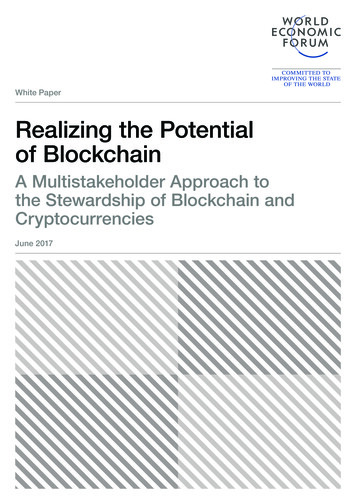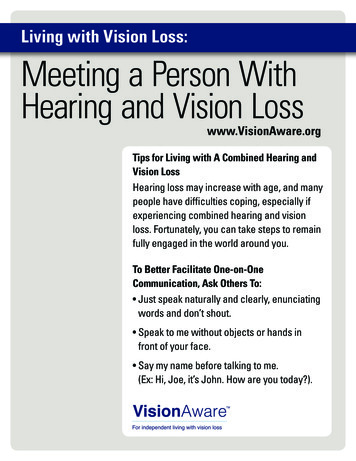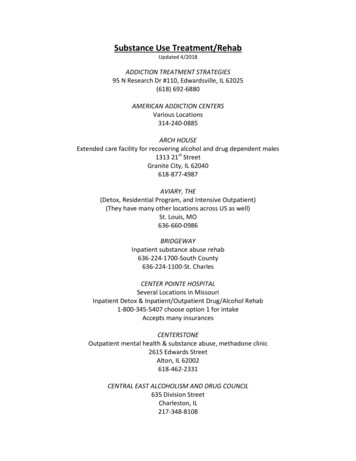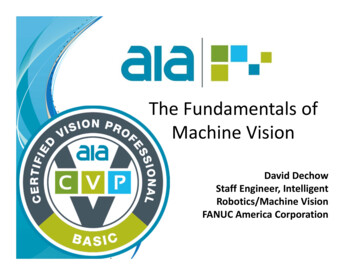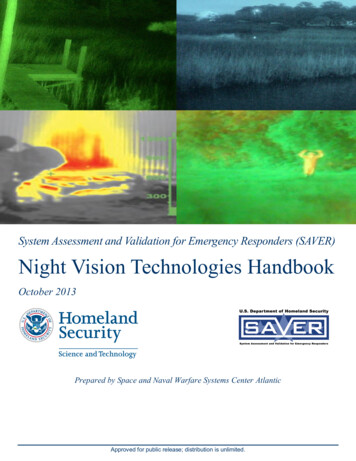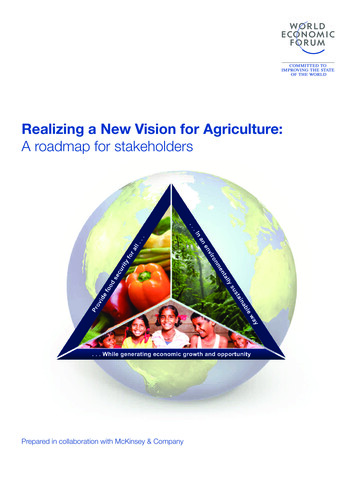
Transcription
Realizing a New Vision for Agriculture:A roadmap for stakeholdersPrepared in collaboration with McKinsey & Company
ContentsExecutive Summary4The Need for a New Vision6The Goals of the New Vision12Generating a Virtuous Cycle17Models of Collaboration19Moving Forward Together22Appendices24Acknowledgements28The views expressed in this publication do not necessarily reflectthose of the World Economic Forum.World Economic Forum91-93 route de la CapiteCH-1223 Cologny/GenevaSwitzerlandTel.: 41 (0)22 869 1212Fax: 41 (0)22 786 2744E-mail: contact@weforum.orgwww.weforum.org 2010 World Economic ForumAll rights reserved.No part of this publication can be reproduced ortransmitted in any form or by any means, includingphotocopying and recording, or by any informationretrieval or storage system.Photographs by Brent Stirton, courtesy of Getty Images(inside covers, p 14, 16, 19, 20, 21, 22)REF: 131210
PrefaceThe World Economic Forum is pleased to present this roadmap for realizing a New Vision for Agriculture, which is theoutcome of an 18-month process that engaged global and regional stakeholders around the world.The World Economic Forum’s New Vision for Agriculture initiative is led by 17 global companies that are Industry Partnersof the Forum. The initiative addresses the major challenges of global food and agricultural sustainability based on a visionof agriculture as a positive contributor to food security, environmental sustainability and economic opportunity. To advanceprogress toward that vision, this roadmap outlines a framework for action to implement business-led and market-basedsolutions that are explicitly linked to national development priorities.Over the past 18 months, the initiative has outlined its vision and worked intensively with global and regional stakeholdersto identify priorities for action and opportunities for collaboration. Through leadership-level brainstorming sessionsin Tanzania, Vietnam, India, the United States and Switzerland, the initiative engaged over 350 leaders of business,government, civil society, international organizations and academia. In the process, it catalysed two country-levelpartnerships in Tanzania and Vietnam to put its ideas into action. These and other innovative models of collaboration willbe discussed by global leaders at the World Economic Forum Annual Meeting 2011 in Davos-Klosters, Switzerland.Many partners and constituents contributed to the roadmap. The 17 global companies that championed the initiativeare Archer Daniels Midland, BASF, Bunge, Cargill, The Coca-Cola Company, DuPont, General Mills, Kraft Foods, Metro,Monsanto Company, Nestlé, PepsiCo, SABMiller, Syngenta, Unilever, Wal-Mart Stores and Yara International. Theycontributed tremendous leadership and technical expertise through a project board and working group, whose membersare listed in the Annex.McKinsey & Company served as project adviser for the initiative, contributing substantial time and analysis through adedicated team of experts. The International Food Policy Research Institute served as a knowledge partner, providingexpertise to global and regional discussions. The World Economic Forum’s Global Agenda Council on Food Security, ahigh-level multistakeholder group, served in an advisory role.Eight members of the Schwab Foundation for Social Entrepreneurship also provided input. A number of academic andinstitutional experts provided input and review. Farmer leaders participated in each of the regional leadership dialogues,providing key insights and recommendations that shaped this roadmap. These contributors are also listed in the Annex.This roadmap carries a key message that the private sector is ready to be a partner and driver of solutions for sustainableagriculture. However, the private sector cannot accomplish these goals alone. Partnership among stakeholders, andeffective government leadership in particular, is critical to success. We hope this roadmap will encourage many others toinitiate action or collaborative efforts to achieve our shared goals for a sustainable future.Robert GreenhillManaging DirectorWorld Economic ForumSarita NayyarSenior Director, Consumer IndustriesWorld Economic Forum USAA New Vision for Agriculture 3
Executive SummaryThe World Needs a New Vision for AgricultureAgriculture provides much more than food. It offers essential commodities, environmental services and social goodsthat facilitate economic development, industrialization and diversification. From its inception, the purpose of agriculturehas been to feed and fuel human activity. And now, it is more important than ever.The world must produce more with less. The sector is entering a new era, marked by scarcer resources, greaterdemand and higher risks of volatility. Since agriculture accounts for 70% of water use and up to 30% of greenhouse gasemissions, it contributes to and is threatened by environmental degradation. This will be exacerbated as the growingpopulation demands more food – nearly double today’s levels by 2050 – and more resource-intensive produce such asmeat and dairy.Agriculture can better fulfil the world’s most basic social needs. Nearly 1 billion people go hungry today – half ofthem farmers – and malnutrition severely impedes human and economic development. Three-quarters of the poor livein rural areas, most relying on agriculture for their livelihood. In many regions, women contribute the bulk of farm labour.Farmers can be among the greatest beneficiaries of agricultural development and are at the core of the solution.The Time to Act Is Now:Committing to rFOOD SECURITYECURITYen.anywaThese goals are intended to build on theMillennium Development Goals and otherinternational targets by coordinating andconcentrating the efforts of agricultural playersaround the world. The New Vision for Agriculture strives toharness the power of agriculture to drive foodsecurity, environmental sustainability andeconomic opportunity. Its aspirations are high,not least of which are to increase productionby 20% while decreasing emissions by 20%and reducing the prevalence of rural poverty by20% every decade.while generating economic growth and opportunityECONOMIC OPPORTUNITYWe must act together with scale and speed. Market-based approaches are essential to implementing viablesolutions, as is collaboration among farmers, private industry, governments and civil society. The challenge is enormous,but the opportunity is both substantial and achievable.Innovative Tools Can Break Bottlenecks in the Value ChainConstraints can be found at every stage of the agricultural chain, from research to consumption. Whilecommon problems affect agriculture in many countries, such as inadequate access to inputs, finance and storage, themost effective solutions to breaking these bottlenecks vary between regions and systems.Agriculture is and must continue to be innovation-driven. Many players have developed highly effective pointinterventions to address bottlenecks in the value chain, improving input technologies and farmer capabilities, for example.The technical know-how of global institutions must be combined with the resourceful acumen of local entrepreneurs toinspire new breakthroughs. Achieving the New Vision requires a greater number of these successes, adopted quickly atscale.4 A New Vision for Agriculture
Sparking a Virtuous Cycle of Increasing Skill and InvestmentRealizing agriculture’s full potential as a driver of foodsecurity, environmental sustainability and economicopportunity requires fundamentally shifting the waythe system operates.aPolicyInfrastructureInnovative tools only work if they are supported bythe right policy, infrastructure and market structure.Improved seed does not yield a full harvest withoutsoil management and storage; an improved harvestcan result in price erosion and regional surplus withoutappropriate market links.bA New Generation of AgriculturalInitiativesIn a few places, governments, businesses and civilsociety are spearheading these virtuous cyclesby orchestrating and accelerating investments tochange agricultural systems holistically. Many suchapproaches are in the early stages, but have thepotential to transform even the most es of robust collaboration concentrate on a particular crop or geographic region, such as value chaininterventions, infrastructure corridors, breadbaskets and national sector transformations. By coordinating their efforts,stakeholders can mitigate risk, leverage their contributions and build on each other’s competencies to harness marketforces for sustainable growth.Every Stakeholder Has a Critical RoleThe scale of the challenge will require everyone tostep up their efforts. Governments must lead, setting thedirection for their country’s transformation and creating theright environment to achieve it.THEFARMERCi vi l Socyi etSectoretbli c Se ctoruPBusinesses drive implementation through innovation,investment and competition. Civil society mobilizes andsupports communities, manages risk, builds local capacityand bridges gaps not addressed by the market.The companies leading this initiative commit torealizing the new vision for agriculture.But they cannot do it alone. What will you do?A New Vision for Agriculture 5Priva
Agriculture Matters30%Proportion of greenhousegas emissions related to agriculture(16% from forestry)40%Share of worldwide employmentin agriculture (including 70% ofthe “bottom billion”)70%Share of worldwide waterwithdrawals from agriculture10,000Years of historical food productionthat must be matched inthe next 50 years925,000,000Hungry people today6 A New Vision for Agriculture
The Need for a New VisionSociety is critically dependent on agriculture. It is the foundation of the food chain and provides 40% of the world’sjobs. From its inception, the purpose of agriculture has been to feed and fuel human activity. Driven by innovation andinvestment, agricultural productivity has increased substantially. Almost 5 billion people have enough to eat today, upfrom only 2 billion half a century ago; in that same period, farmers in some parts of the world have doubled their resourceefficiency. These successes have underpinned unprecedented growth and supported the development of modern society.But agriculture is entering a new era marked by scarcer resources, greater demand and potentially higher price andsupply volatility.Going forward, the world must produce far more with less.Constrained Environmental ResourcesAgricultural growth, although commendable, is placing increasing stress on the earth’s resources. The sector contributesto and is threatened by environmental degradation and climate change. Agriculture accounts for 70% of waterwithdrawals and up to 30% of greenhouse gas emissions (including 16% from deforestation).In recent decades, poor agricultural practices have been a factor in the depletion of soil fertility, species diversity andwater availability and quality. Meanwhile, broader environmental changes are affecting agriculture in ways yet to befully understood. Alterations in climate mean that farmers must adapt to changing rainfall patterns and fluctuations intemperature; yields could be reduced by more than 20% in many areas, with poor countries – and poor farmers – facingparticularly severe outcomes.Growing DemandAgriculture faces the dual challenge of becoming more environmentally sustainable while feeding more people. In thenext 40 years, the global population is expected to increase by one-third, peaking at over 9 billion. The intensity ofconsumption is growing even faster; as incomes rise in emerging markets, new members of the middle class demandmore meat and dairy, which require more resources to produce.Experts project that annual meat production will need to rise by 75% – to 470 million tonnes – by 2050. Societies will beforced to make difficult trade-offs in allocating resources. Riots over the last few years remind us that food uncertainty canrapidly undermine basic stability.With 70% of the world’s population expected to live in cities by 2050, the need for effective food distribution – linkinggrowers to retailers to consumers – will intensify. Urban populations demand more processed and ready-to-eat food, aswell as more diverse options. This will increase the role of processing, packaging and logistics providers in food systems.Water availability — 30% crop production at risk by 2025GHG Emissions — Agriculture and forestry contribute ustry,power8Transport14 3Waste161413ForestryAgriculture22Industry, directSource: UNEPSource: IEAA New Vision for Agriculture 7
Soil — Poor soil health threatens yieldsClimate change — yields potentially depressed 20% inmany areasSource: SAGESource: World BankBasic Social NeedsAgriculture is a principal platform for human development and socialwelfare. It is the foundation upon which diverse economies have been builtand provides a pathway out of poverty for millions.Agricultural development is an opportunity to better meet these basicneeds. Nearly 1 billion people are hungry today – half of them farmers.Three-quarters of the poor in developing countries live in rural areas – over2 billion people get by on less than US 2 a day.“If we are serious about endingextreme hunger and poverty aroundthe world, we must be seriousabout transforming agriculture.”William H. GatesCo-Chair, Bill & Melinda Gates FoundationThese issues are inextricably linked, particularly in developing countries, where the poor spend a high proportion oftheir income on food. Poverty usually leads to malnutrition, causing physiological and cognitive damage, depletingcapital, increasing vulnerability and diminishing productivity at both the individual and national levels. Child malnutrition isparticularly detrimental, as many of the health impacts incurred between conception and two years of age are irreversible.Undernutrition — Linked to one-third of all deathsamongst children under 5 in developing world% children underweight 10-2030-40Inversely, overconsumption andimbalanced dietsincreasing ratesof obesity andchronic illnessMalnutrition in children leadsto permanently reducedphysical/mental capacitiesSource: CIESIN8 A New Vision for Agriculture50 40% in India,BangladeshHealthcare — Both production and consumption declinewhen illness strikes rural householdsAdult HIV prevalence 0.1% 0.5%1%5% 15% 100%Largestpopulationsliving withHIVSSA accounts for: 67% of HIV 60% of Malaria 27% of TBSource: UNAIDS/WHOinfections globally;both increasing and increased by highfood insecurity
Povertyhunger and malnutritionlow productivity andlack of capitalphysical and cognitiveunderdevelopmentThese cross-cutting issues form vicious cycles of deprivation, particularly in rural areas. They are often aggravated by theabsence of basic services such as healthcare and education, further impeding the potential for human development.These issues pose particularly severe challenges for women, who in many regions have both the greatest responsibilityand the fewest resources by which to ensure food security food for their communities. Limited access to land, finance andtraining together with cultural factors constrain women’s ability to produce and deliver adequate nutrition for their families.Education — Lowering productivity, earning potential,capacity of rural developmentProjected number of adult illiterates(age 15 ), 20155 MM women5 MM menGender inequity — Driving resource misallocationPercent, developing countriesMale 776mn adults are illiterate;two-thirds are women 75mn children are out of school 32mn of them are in SSA alone 4 out of 5 out-of-school kidsare in rural areasS/ WAsi aSSASource: UNESCO EFAEAsi a/PacArabstatesLatAm/Cari b16% adultilliteracyFemale30959910% ofsmallfarmercredit70Up to 10%in reAgcredit98Source: Bill and Melinda Gates FoundationA New Vision for Agriculture 9
Rethinking AgricultureUnderdevelopment in rural areas pushes individuals to follow economic opportunity into the city, leaving the mostvulnerable behind. Agricultural development can mitigate this trend by cultivating rural opportunity and more inclusivesocietal growth.Given the stakes, the world must deliver on agriculture’s full potential. The approaches of the past simply cannot meet thechallenges ahead. Building on successes, we must proactively factor in the cost of natural resources, the need to boostproduction in developing countries and ways to provide hungry people with basic nutrition. This will be one of the greatestchallenges of our generation.The time has come for a New Vision for Agriculture.Yesterday’s opeimprovement. will not be sufficient tomorrowConvert potential arable land tocroplandDiminishing land availability, soildegradation, high environmental costRapid scaling of irrigated land area,overdraw on groundwaterDepleted ground water stores renderurgent water efficiency measuresAgriculture’s environmental impactaccepted or ignoredEnvironmental sustainability as necessarystipulationReliance on increased yields indeveloped countriesYield growth in developing countriesvital to meet global demandAcceptance of low smallholderproductivitySmallholder improvements critical toaddress global hunger and povertyPriority on calories and increasingcereal productionImportance of crop diversity, nutritionalcontent and food affordabilityFocus on farm-level output and yieldEfficiency in whole value chain necessaryfor access, food security10 A New Vision for Agriculture
Farmers at the ForefrontEfrén Rizo, NicaraguaIn the impoverished province of Jinotega, more than 80% of thepopulation earns less than US 1 a day.The 22 vegetable farmers who comprise the Tomatoya-ChagüiteGrande cooperative were once stuck in this cycle of extremepoverty. Efrén Rizo, the cooperative’s president, and his familyoften suffered from hunger because of their low income.Tomatoya-Chagüite Grande worked with TechnoServe to improvethe quality of their harvest and secure supply orders from leadingsupermarkets.They now sell directly to Nicaragua’s largest supermarket chain,earning 10 times their previous income. Today, Rizo earns enoughto provide his children with the education he never received.Source: TechnoServeSuzanne Tsovalae, MadagascarClay Mitchell, United StatesSuzanne Tsovalae, 23 years old, is a farmer in theTanandava village. She supports her family by growingsweet potatoes and beans, raising small livestock, andbuying and selling fish and prickly pear in the regionalmarket.Clay Mitchell and his father Wade operate a fifthgeneration, 1,000 hectare, non-irrigated corn andsoybean farm in the state of Iowa. A leader in no-tilltechniques and novel agronomic systems, the MitchellFarm is best known for the applying automation andGPS data to achieve large savings in seed, fertilizer andchemical use (10%, 10% and 20%, respectively) whileconsistently delivering high yields.Tsovalae’s livelihood is dependent on the harvest, whichis dependent on the rain. She has not heard of climatechange (news only transmits from a few local radios)but recognizes that increasingly volatile floods anddroughts are forcing villagers to go hungry or migrate.She believes she will always be a farmer, but says, “I willdo my utmost in commerce not to fall into poverty.” Shehas never received training and uses very rudimentaryfarming practices. Her basic education allows her toread and use currency at the market. Without access toa bank and hesitant to keep cash, she “stores” moneyby accumulating chickens.She feels her life has been steadily improving, andcredits her initiative in small commerce. She has towalk great distances to trade, though, and would like tosee a marketpla
Dec 01, 2011 · providing key insights and recommendations that shaped this roadmap. These contributors are also listed in the Annex. This roadmap carries a key message that the private sector is ready to be a partner and driver of solutions for sustainable agriculture. However



